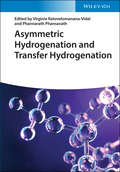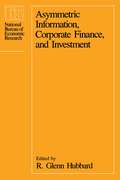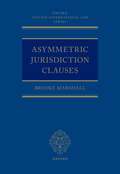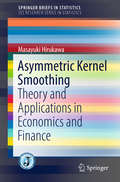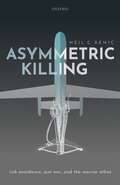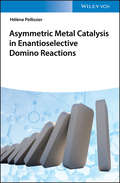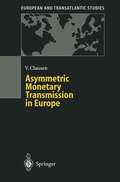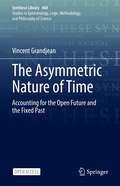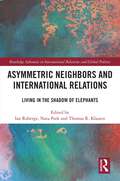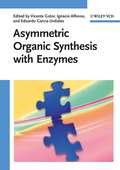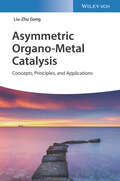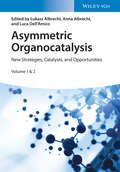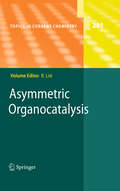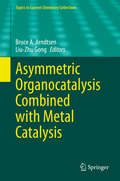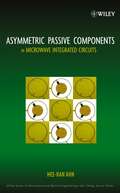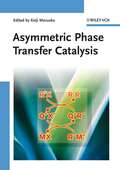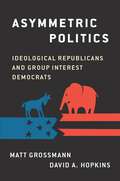- Table View
- List View
Asymmetric Hydrogenation and Transfer Hydrogenation
by Virginie Ratovelomanana-Vidal Phannarath PhansavathDiscover the latest developments in homogeneous asymmetric (transfer) hydrogenation with this up-to-date resource Asymmetric Hydrogenation and Transfer Hydrogenation delivers a current and cutting-edge investigation of homogenous asymmetric hydrogenation and transfer hydrogenation reactions of prochiral substrates by using organometallic catalysts (like ruthenium, rhodium, iridium, iron, and copper) and organic catalysts. Distinguished researchers and editors Virginie Ratovelomanana-Vidal and Phannarath Phansavath also offer readers a comprehensive walkthrough of substituted ketones through dynamic kinetic resolution, as well a presentation of the mechanisms and application of asymmetric hydrogenation reactions to the synthesis of biologically relevant compounds. The book comprehensively details its complex subject matter clearly and plainly and covers everything from catalyst development and reactions to mechanisms and applications in academia and industry. The papers included within come from many of the leading voices in their respective fields and represent the newest and best research available today. Compiled for researchers and private-industry chemists alike, Asymmetric Hydrogenation and Transfer Hydrogenation also discusses a wide variety of other topics like: A discussion of the development of chiral metal catalysts for asymmetric transfer hydrogenation Several examinations of asymmetric transfer hydrogenation of a variety of chemical groups, including ketones, aryl and heteroaryl ketones, substituted ketones, and heteroaromatic compounds, akenes, and imines An exploration of the mechanism of asymmetric hydrogenation and continuous flow asymmetric hydrogenation A full and thorough treatment of the industrial applications of asymmetric hydrogenation Perfect for catalytic chemists, chemists working on or with organometallics, organic chemists, natural product chemists, pharmaceutical chemists, medicinal chemists, and industrial chemists, Asymmetric Hydrogenation and Transfer Hydrogenation also belongs on the bookshelves of research and university institutes and libraries who wish to expand their selection on a topic fundamental to organic synthesis.
Asymmetric Information, Corporate Finance, and Investment (National Bureau of Economic Research Project Report)
by R. Glenn HubbardIn this volume, specialists from traditionally separate areas in economics and finance investigate issues at the conjunction of their fields. They argue that financial decisions of the firm can affect real economic activity—and this is true for enough firms and consumers to have significant aggregate economic effects. They demonstrate that important differences—asymmetries—in access to information between "borrowers" and "lenders" ("insiders" and "outsiders") in financial transactions affect investment decisions of firms and the organization of financial markets. The original research emphasizes the role of information problems in explaining empirically important links between internal finance and investment, as well as their role in accounting for observed variations in mechanisms for corporate control.
Asymmetric Jurisdiction Clauses (Oxford Private International Law Series)
by Brooke MarshallAsymmetric jurisdiction clauses, giving one party a right to choose the forum for litigation after a dispute has already arisen, are widespread in international commercial contracting. And yet for close to a decade their enforceability and effects under EU law have been uncertain, with seven different competing decisions from France's highest court progressively contributing to the murky waters. From the interpretation of material changes to the Brussels I Recast Regulation, to obiter comments by English judges as to whether the 2005 Hague Choice of Court Convention on 'exclusive' jurisdiction clauses applies to asymmetric clauses, how can lawyers balance certainty, flexibility, and risk in this difficult legal landscape? This book explores this conundrum and aims to bring clarity to the current law on asymmetric jurisdiction clauses in the EU, England, and Contracting States to the Hague Convention 2005. It seeks to prompt practitioners and scholars to reflect carefully and critically on how and why asymmetric clauses are used, whether courts will -and should- hold businesses to them, and how both the law and the clauses themselves could be better designed in the future.
Asymmetric Jurisdiction Clauses (Oxford Private International Law Series)
by Brooke MarshallAsymmetric jurisdiction clauses, giving one party a right to choose the forum for litigation after a dispute has already arisen, are widespread in international commercial contracting. And yet for close to a decade their enforceability and effects under EU law have been uncertain, with seven different competing decisions from France's highest court progressively contributing to the murky waters. From the interpretation of material changes to the Brussels I Recast Regulation, to obiter comments by English judges as to whether the 2005 Hague Choice of Court Convention on 'exclusive' jurisdiction clauses applies to asymmetric clauses, how can lawyers balance certainty, flexibility, and risk in this difficult legal landscape? This book explores this conundrum and aims to bring clarity to the current law on asymmetric jurisdiction clauses in the EU, England, and Contracting States to the Hague Convention 2005. It seeks to prompt practitioners and scholars to reflect carefully and critically on how and why asymmetric clauses are used, whether courts will -and should- hold businesses to them, and how both the law and the clauses themselves could be better designed in the future.
Asymmetric Kernel Smoothing: Theory and Applications in Economics and Finance (SpringerBriefs in Statistics)
by Masayuki HirukawaThis is the first book to provide an accessible and comprehensive introduction to a newly developed smoothing technique using asymmetric kernel functions. Further, it discusses the statistical properties of estimators and test statistics using asymmetric kernels. The topics addressed include the bias-variance tradeoff, smoothing parameter choices, achieving rate improvements with bias reduction techniques, and estimation with weakly dependent data. Further, the large- and finite-sample properties of estimators and test statistics smoothed by asymmetric kernels are compared with those smoothed by symmetric kernels. Lastly, the book addresses the applications of asymmetric kernel estimation and testing to various forms of nonnegative economic and financial data. Until recently, the most popularly chosen nonparametric methods used symmetric kernel functions to estimate probability density functions of symmetric distributions with unbounded support. Yet many types of economic and financial data are nonnegative and violate the presumed conditions of conventional methods. Examples include incomes, wages, short-term interest rates, and insurance claims. Such observations are often concentrated near the boundary and have long tails with sparse data. Smoothing with asymmetric kernel functions has increasingly gained attention, because the approach successfully addresses the issues arising from distributions that have natural boundaries at the origin and heavy positive skewness. Offering an overview of recently developed kernel methods, complemented by intuitive explanations and mathematical proofs, this book is highly recommended to all readers seeking an in-depth and up-to-date guide to nonparametric estimation methods employing asymmetric kernel smoothing.
Asymmetric Killing: Risk Avoidance, Just War, and the Warrior Ethos
by Neil C. RenicThis book offers an engaging and historically informed account of the moral challenge of radically asymmetric violence — warfare conducted by one party in the near-complete absence of physical risk, across the full scope of a conflict zone. What role does physical risk and material threat play in the justifications for killing in war? And crucially, is there a point at which battlefield violence becomes so one-directional as to undermine the moral basis for its use? In order to answers these questions, Asymmetric Killing delves into the morally contested terrain of the warrior ethos and Just War Tradition, locating the historical and contemporary role of reciprocal risk within both. This book also engages two historical episodes of battlefield asymmetry, military sniping and manned aerial bombing. Both modes of violence generated an imbalance of risk between opponents so profound as to call into question their permissibility. These now-resolved controversies will then be contrasted with the UAV-exclusive violence of the United States, robotic killing conducted in the absence of a significant military ground presence in conflict theatres such as Pakistan, Yemen, and Somalia. As will be revealed, the radical asymmetry of this latter case is distinct, undermining reciprocal risk at the structural level of war. Beyond its more resolvable tension with the warrior ethos, UAV-exclusive violence represents a fundamental challenge to the very coherence of the moral justifications for killing in war.
Asymmetric Killing: Risk Avoidance, Just War, and the Warrior Ethos
by Neil C. RenicThis book offers an engaging and historically informed account of the moral challenge of radically asymmetric violence — warfare conducted by one party in the near-complete absence of physical risk, across the full scope of a conflict zone. What role does physical risk and material threat play in the justifications for killing in war? And crucially, is there a point at which battlefield violence becomes so one-directional as to undermine the moral basis for its use? In order to answers these questions, Asymmetric Killing delves into the morally contested terrain of the warrior ethos and Just War Tradition, locating the historical and contemporary role of reciprocal risk within both. This book also engages two historical episodes of battlefield asymmetry, military sniping and manned aerial bombing. Both modes of violence generated an imbalance of risk between opponents so profound as to call into question their permissibility. These now-resolved controversies will then be contrasted with the UAV-exclusive violence of the United States, robotic killing conducted in the absence of a significant military ground presence in conflict theatres such as Pakistan, Yemen, and Somalia. As will be revealed, the radical asymmetry of this latter case is distinct, undermining reciprocal risk at the structural level of war. Beyond its more resolvable tension with the warrior ethos, UAV-exclusive violence represents a fundamental challenge to the very coherence of the moral justifications for killing in war.
Asymmetric Metal Catalysis in Enantioselective Domino Reactions
by Helene PellissierIntroduces an innovative and outstanding tool for the easy synthesis of complex chiral structures in a single step Covering all of the literature since the beginning of 2006, this must-have book for chemists collects the major progress in the field of enantioselective one-, two-, and multicomponent domino reactions promoted by chiral metal catalysts. It clearly illustrates how enantioselective metal-catalyzed processes constitute outstanding tools for the development of a wide variety of fascinating one-pot asymmetric domino reactions, thereby allowing many complex products to be easily generated from simple materials in one step. The book also strictly follows the definition of domino reactions by Tietze as single-, two-, as well as multicomponent transformations. Asymmetric Metal Catalysis in Enantioselective Domino Reactions is divided into twelve chapters, dealing with enantioselective copper-, palladium-, rhodium-, scandium-, silver-, nickel-, gold-, magnesium-, cobalt-, zinc-, yttrium and ytterbium-, and other metal-catalyzed domino reactions. Most of the chapters are divided into two parts dealing successively with one- and two-component domino reactions, and three-component processes. Each part is subdivided according to the nature of domino reactions. Each chapter of the book includes selected applications of synthetic methodologies to prepare natural and biologically active products. -Presents the novel combination of asymmetric metal catalysis with the concept of fascinating domino reactions, which allows high molecular complexity with a remarkable level of enantioselectivity -Showcases an incredible tool synthesizing complex and diverse chiral structures in a single reaction step -Includes applications in total synthesis of natural products and biologically active compounds -Written by a renowned international specialist in the field -Stimulates the design of novel asymmetric domino reactions and their use in the synthesis of natural products, pharmaceuticals, agrochemicals, and materials Asymmetric Metal Catalysis in Enantioselective Domino Reactions will be of high interest to synthetic, organic, medicinal, and catalytic chemists in academia and R&D departments.
Asymmetric Metal Catalysis in Enantioselective Domino Reactions
by Helene PellissierIntroduces an innovative and outstanding tool for the easy synthesis of complex chiral structures in a single step Covering all of the literature since the beginning of 2006, this must-have book for chemists collects the major progress in the field of enantioselective one-, two-, and multicomponent domino reactions promoted by chiral metal catalysts. It clearly illustrates how enantioselective metal-catalyzed processes constitute outstanding tools for the development of a wide variety of fascinating one-pot asymmetric domino reactions, thereby allowing many complex products to be easily generated from simple materials in one step. The book also strictly follows the definition of domino reactions by Tietze as single-, two-, as well as multicomponent transformations. Asymmetric Metal Catalysis in Enantioselective Domino Reactions is divided into twelve chapters, dealing with enantioselective copper-, palladium-, rhodium-, scandium-, silver-, nickel-, gold-, magnesium-, cobalt-, zinc-, yttrium and ytterbium-, and other metal-catalyzed domino reactions. Most of the chapters are divided into two parts dealing successively with one- and two-component domino reactions, and three-component processes. Each part is subdivided according to the nature of domino reactions. Each chapter of the book includes selected applications of synthetic methodologies to prepare natural and biologically active products. -Presents the novel combination of asymmetric metal catalysis with the concept of fascinating domino reactions, which allows high molecular complexity with a remarkable level of enantioselectivity -Showcases an incredible tool synthesizing complex and diverse chiral structures in a single reaction step -Includes applications in total synthesis of natural products and biologically active compounds -Written by a renowned international specialist in the field -Stimulates the design of novel asymmetric domino reactions and their use in the synthesis of natural products, pharmaceuticals, agrochemicals, and materials Asymmetric Metal Catalysis in Enantioselective Domino Reactions will be of high interest to synthetic, organic, medicinal, and catalytic chemists in academia and R&D departments.
Asymmetric Monetary Transmission in Europe (European and Transatlantic Studies)
by Volker ClausenThe euro and the ESCB have started in January 1999 and there is naturally a wide-ranging interest in academia and among policymakers in OECD coun tries, how successful European Monetary Union will and can be. EMU has started with 11 countries and experienced a rapid depreciation of the cur rency. With so many EU countries joining for a historical monetary union in a period of economic globalization, international financial market changes and ongoing EU enlargement the problem of monetary policy efficiency becomes crucial; especially as so many countries in the EU still have high unemploy ment rates and the euro has just started at the beginning of a cyclical upswing in the euro zone. Monetary policy is also quite crucial, because the Maastricht convergence criteria severely restrict the scope of national fiscal policy. With a very limited stock of valuable European monetary experience which could be usefully exploited by the ECB and the ESCB respectively, one naturally will appreciate advanced economic modeling of the main issues. This book takes an analytical look at the problem of asymmetric monetary transmission in Euroland. Facing the ECB's monetary policy, individual mem ber countries are likely to experience different policy effects. Countries differ in their financial structure -a well-known argument in the literature -but also in the characteristics of goods and labor markets. The latter fields have been somewhat neglected in the literature but receive broad analytical attention here.
The Asymmetric Nature of Time: Accounting for the Open Future and the Fixed Past (Synthese Library #468)
by Vincent GrandjeanThis open access monograph offers a detailed study and a systematic defense of a key intuition we typically have, as human beings, with respect to the nature of time: the intuition that the future is open, whereas the past is fixed. For example, whereas it seems unsettled whether there will be a fourth world war, it is settled that there was a first world war.The book contributes, in particular, three major and original insights. First, it provides a coherent, non-metaphorical, and metaphysically illuminating elucidation of the intuition. Second, it determines which model of the temporal structure of the world is most appropriate to accommodate the intuition, and settles on a specific version of the Growing Block Theory of time (GBT). Third, it puts forward a naturalistic foundation for GBT, by exploiting recent results of our best physics (viz. General Relativity, Quantum Mechanics, and Quantum Gravity). Three main challenges are addressed: the dismissal of temporal asymmetries as non-fundamental phenomena only (e.g., thermodynamic or causal phenomena), the epistemic objection against GBT, and the apparent tension between GBT and relativistic physics. It is argued that the asymmetry between the open future and the fixed past must be grounded in the temporal structure of the world, and that this is neither precluded by our epistemic device, nor by the latest approaches to Quantum Gravity (e.g., the Causal Set Theory). Aiming at reconciling time as we find it in ordinary experience and time as physics describes it, this innovative book will raise the interest of both academic researchers and graduate students working on the philosophy of time. More generally, it presents contents of interest for all metaphysicians and non-dogmatic philosophers of physics.This is an open access book.
Asymmetric Neighbors and International Relations: Living in the Shadow of Elephants (Routledge Advances in International Relations and Global Politics)
by Ian Roberge Nara Park Thomas R. KlassenWith a range of case studies from every continent, the contributors to this book analyze the challenges that arise for states living with much larger neighbors, and the policies they develop to account for this asymmetry. Bringing together the perspectives of bilateral relations and the study of small states, this book analyzes a range of scenarios where one or more smaller countries must manage relations with a much larger neighbor or neighbors, from the perspective of the smaller countries. Each case presents different priorities, depending on the relationship between the states concerned, while highlighting the commonalities across the various scenarios. The range of cases and contributors is wide and diverse, with examples including Togo’s relationship with Ghana, Mongolia’s with China, and Colombia’s with Brazil – as well as more widely known examples such as Canada and the United States, or Australia and New Zealand. A valuable resource for scholars and students of international relations, and public policy of small- and medium-sized states.
Asymmetric Neighbors and International Relations: Living in the Shadow of Elephants (Routledge Advances in International Relations and Global Politics)
With a range of case studies from every continent, the contributors to this book analyze the challenges that arise for states living with much larger neighbors, and the policies they develop to account for this asymmetry. Bringing together the perspectives of bilateral relations and the study of small states, this book analyzes a range of scenarios where one or more smaller countries must manage relations with a much larger neighbor or neighbors, from the perspective of the smaller countries. Each case presents different priorities, depending on the relationship between the states concerned, while highlighting the commonalities across the various scenarios. The range of cases and contributors is wide and diverse, with examples including Togo’s relationship with Ghana, Mongolia’s with China, and Colombia’s with Brazil – as well as more widely known examples such as Canada and the United States, or Australia and New Zealand. A valuable resource for scholars and students of international relations, and public policy of small- and medium-sized states.
Asymmetric Organic Synthesis with Enzymes
by Vicente Gotor Ignacio Alfonso Eduardo García-UrdialesPerfect for biochemists, synthetic and organic chemists, this book covers all important reactions, including C-C coupling reactions, oxidation reactions and many more. Divided into two parts, the first section on methodology presents new innovative methods for enzymatic catalysis optimization, including such new trends as medium engineering, directed evolution and computer-aided prediction of enantioselectivity. The second and main section deals with applications to synthesis, showing important reaction types and their applications. Only those reactions with very high selectivity are presented, allowing readers to improve their own reaction yields.
Asymmetric Organo-Metal Catalysis: Concepts, Principles, and Applications
by Liu-Zhu GongExplore the latest advances involving organo/metal combined catalysts from leading contributors in the field In Asymmetric Organo-Metal Catalysis: Concepts, Principles, and Applications, accomplished chemist Liu-Zhu Gong delivers a comprehensive discussion of how to design efficient organo/metal combined catalyst systems, new cooperatively catalyzed asymmetric reactions, relay catalytic cascades, and multicomponent reactions. The distinguished author covers critical topics, like the combined catalysis of chiral phase transfer catalysts, enamine, iminium, nucleophilic Lewis base, or Bronsted acids with metal complexes, while also covering the cooperative catalysis of photocatalysts and organocatalysts. The book offers readers an exploration of the general concepts and principles of bond activation and reorganization, together with a comprehensive introduction to the historical developments and recent advances in the field. Readers will also benefit from the descriptions of new chemistry and new synthetic methods included within. Asymmetric Organo-Metal Catalysis also provides: Thorough introductions to chiral PTC-metal cooperative catalysis and enamine-metal cooperative catalysis Comprehensive explorations of iminum-metal relay catalysis and cooperative catalysis of bronsted acids and transition metals Practical discussions of metal-bronsted acid relay catalysis and Lewis base–Lewis acid cooperative catalysis In-depth examinations of Lewis base-transition metal cooperative catalysis and photocatalysis combined with organocatalysis Perfect for organic, catalytic, and pharmaceutical chemists, Asymmetric Organo-Metal Catalysis: Concepts, Principles, and Applications is also an invaluable resource for chemists working with or on organometallics.
Asymmetric Organocatalysis: New Strategies, Catalysts, and Opportunities, 2 Volumes
by Lukasz AlbrechtAsymmetric Organocatalysis Comprehensive resource on the latest and most important developments in the highly vivid field of asymmetric organocatalysis The book provides a comprehensive overview of the most important advancements in the field of asymmetric organocatalysis that have occurred within the last decade. It presents valuable examples of newly developed synthetic methodologies based on various organocatalytic activation modes. Special emphasis is given to strategies where organocatalysis is expanding its potential by pushing the boundaries and founding new synergistic interactions with other fields of synthetic chemistry, such as metal catalysis, photocatalysis, and biocatalysis. The application of different concepts (such as vinylogy, dearomatization, or cascade reactivity), resulting in the development of new functionalization strategies, is also discussed. Sample topics covered within the book include: New developments in enantioselective Brønsted acid catalysis with strong hydrogen-bond donors Asymmetric phase-transfer catalysis, from classical applications to new concepts Halogen-bonding organocatalysis Asymmetric electrochemical organocatalysis and synergistic organo-organocatalysis Immobilized organocatalysts for enantioselective continuous flow processes Mechanochemistry and high-pressure techniques in asymmetric organocatalysis Useful tools in elucidation of organocatalytic reaction mechanisms With an overall focus on new reactions and catalysts, this two-volume work is an indispensable source for everyone working in the field of asymmetric organocatalysis.
Asymmetric Organocatalysis: New Strategies, Catalysts, and Opportunities, 2 Volumes
by Lukasz Albrecht Anna Albrecht Luca Dell'AmicoAsymmetric Organocatalysis Comprehensive resource on the latest and most important developments in the highly vivid field of asymmetric organocatalysis The book provides a comprehensive overview of the most important advancements in the field of asymmetric organocatalysis that have occurred within the last decade. It presents valuable examples of newly developed synthetic methodologies based on various organocatalytic activation modes. Special emphasis is given to strategies where organocatalysis is expanding its potential by pushing the boundaries and founding new synergistic interactions with other fields of synthetic chemistry, such as metal catalysis, photocatalysis, and biocatalysis. The application of different concepts (such as vinylogy, dearomatization, or cascade reactivity), resulting in the development of new functionalization strategies, is also discussed. Sample topics covered within the book include: New developments in enantioselective Brønsted acid catalysis with strong hydrogen-bond donors Asymmetric phase-transfer catalysis, from classical applications to new concepts Halogen-bonding organocatalysis Asymmetric electrochemical organocatalysis and synergistic organo-organocatalysis Immobilized organocatalysts for enantioselective continuous flow processes Mechanochemistry and high-pressure techniques in asymmetric organocatalysis Useful tools in elucidation of organocatalytic reaction mechanisms With an overall focus on new reactions and catalysts, this two-volume work is an indispensable source for everyone working in the field of asymmetric organocatalysis.
Asymmetric Organocatalysis: From Biomimetic Concepts to Applications in Asymmetric Synthesis
by Albrecht Berkessel Harald GrögerAsymmetric catalysis represents still one of the major challenges in modern organic chemistry. Besides the well-established asymmetric metal-complex-catalysed syntheses and biocatalysis, the use of "pure" organic catalysts turned out to be an additional efficient tool for the synthesis of chiral building blocks. In this handbook, the experienced authors from academia and industry provide the first overview of the important use of such metal-free organic catalysts in organic chemistry. With its comprehensive description of numerous reaction types, e.g., nucleophilic substitution and addition reactions as well as cycloadditions and redox reactions, this book targets organic chemists working in industry and academia, and deserves a place in every laboratory.
Asymmetric Organocatalysis: Lewis Base And Acid Catalysts (Topics in Current Chemistry #291)
by Benjamin ListAs nucleophiles, simple alkenes are typically so unreactive that only highly active electrophiles, such as carbocations, peroxides, and halogens will react with them. For the generation of carbon-carbon bonds, milder methods will often be required. Fortunately, it is possible to increase the reactivity of alkene-type p-nucleophiles by introducing electron-donating substituents. Substitution of one H with an OH or OR gives an enol or a vinyl ether, which are already much better nucleophiles. Using nitrogen instead of oxygen, one obtains even better nucleophiles, enamines. Enamines are among the most reactive neutral carbon nucleophiles, exhibiting rates that are even comparable to some charged nucleophiles, such as enolates [1, 2]. Most enamines, unfortunately, are sensitive to hydrolysis.
Asymmetric Organocatalysis Combined with Metal Catalysis (Topics in Current Chemistry Collections)
The series Topics in Current Chemistry Collections presents critical reviews from the journal Topics in Current Chemistry organized in topical volumes. The scope of coverage is all areas of chemical science including the interfaces with related disciplines such as biology, medicine and materials science. The goal of each thematic volume is to give the non-specialist reader, whether in academia or industry, a comprehensive insight into an area where new research is emerging which is of interest to a larger scientific audience.Each review within the volume critically surveys one aspect of that topic and places it within the context of the volume as a whole. The most significant developments of the last 5 to 10 years are presented using selected examples to illustrate the principles discussed. The coverage is not intended to be an exhaustive summary of the field or include large quantities of data, but should rather be conceptual, concentrating on the methodological thinking that will allow the non-specialist reader to understand the information presented. Contributions also offer an outlook on potential future developments in the field.The chapter "Enamine/Transition Metal Combined Catalysis: Catalytic Transformations Involving Organometallic Electrophilic Intermediates" is available open access under a CC BY 4.0 License via link.springer.com.
Asymmetric Organocatalysis in Natural Product Syntheses (Progress in the Chemistry of Organic Natural Products #96)
by Mario WaserThis book provides the reader with an illustrative overview concerning successful and widely used applications of organocatalysis in the field of natural product synthesis. The main focus will be on organocatalytic key-steps for each (multi-step) synthesis described, whereas other often particularly innovative transformations will be omitted, as this would be beyond the scope of this volume.
Asymmetric Passive Components in Microwave Integrated Circuits (Wiley Series in Microwave and Optical Engineering #182)
by Hee-Ran AhnThis book examines the new and important technology of asymmetric passive components for miniaturized microwave passive circuits. The asymmetric design methods and ideas set forth by the author are groundbreaking and have not been treated in previous works. Readers discover how these design methods reduce the circuit size of microwave integrated circuits and are also critical to reducing the cost of equipment such as cellular phones, radars, antennas, automobiles, and robots. An introductory chapter on the history of asymmetric passive components, which began with asymmetric ring hybrids first described by the author, sets the background for the book. It lays a solid foundation with a chapter examining microwave circuit parameters such as scattering, ABCD, impedance, admittance, and image. A valuable feature of this chapter is a conversion table between the various circuit matrices characterizing two-port networks terminated in arbitrary impedances. The correct conversion has also never been treated in previous works. Next, the author sets forth a thorough treatment of asymmetric passive component design, which covers the basic and indispensable elements for integration with other active or passive devices, including: * Asymmetric ring hybrids * Asymmetric branch-line hybrids * Asymmetric three-port power dividers and N-way power dividers * Asymmetric ring hybrid phase shifters and attenuators * Asymmetric ring filters and asymmetric impedance transformers With its focus on the principles of circuit element design, this is a must-have graduate-level textbook for students in microwave engineering, as well as a reference for design engineers who want to learn the new and powerful design method for asymmetric passive components.
Asymmetric Phase Transfer Catalysis
by Keiji MaruokaEdited by the leading expert on the topic, this is the first book to present the latest developments in this exciting field. Alongside the theoretical aspects, the top contributors provide practical protocols to give readers additional important information otherwise unavailable. A must for every synthetic chemist in academia and industry.
Asymmetric Politics: Ideological Republicans and Group Interest Democrats
by Matt Grossmann David A. HopkinsWhy do Republican politicians promise to rein in government, only to face repeated rebellions from Republican voters and media critics for betraying their principles? Why do Democratic politicians propose an array of different policies to match the diversity of their supporters, only to become mired in stark demographic divisions over issue priorities? In short, why do the two parties act so differently-whether in the electorate, on the campaign trail, or in public office? Asymmetric Politics offers a comprehensive explanation: The Republican Party is the vehicle of an ideological movement while the Democratic Party is a coalition of social groups. Republican leaders prize conservatism and attract support by pledging loyalty to broad values. Democratic leaders instead seek concrete government action, appealing to voters' group identities and interests by endorsing specific policies. This fresh and comprehensive investigation reveals how Democrats and Republicans think differently about politics, rely on distinct sources of information, argue past one another, and pursue divergent goals in government. It provides a rigorous new understanding of contemporary polarization and governing dysfunction while demonstrating how longstanding features of American politics and public policy reflect our asymmetric party system.
ASYMMETRIC POLITICS C: Ideological Republicans and Group Interest Democrats
by Matt Grossmann David A. HopkinsWhy do Republican politicians promise to rein in government, only to face repeated rebellions from Republican voters and media critics for betraying their principles? Why do Democratic politicians propose an array of different policies to match the diversity of their supporters, only to become mired in stark demographic divisions over issue priorities? In short, why do the two parties act so differently-whether in the electorate, on the campaign trail, or in public office? Asymmetric Politics offers a comprehensive explanation: The Republican Party is the vehicle of an ideological movement while the Democratic Party is a coalition of social groups. Republican leaders prize conservatism and attract support by pledging loyalty to broad values. Democratic leaders instead seek concrete government action, appealing to voters' group identities and interests by endorsing specific policies. This fresh and comprehensive investigation reveals how Democrats and Republicans think differently about politics, rely on distinct sources of information, argue past one another, and pursue divergent goals in government. It provides a rigorous new understanding of contemporary polarization and governing dysfunction while demonstrating how longstanding features of American politics and public policy reflect our asymmetric party system.
